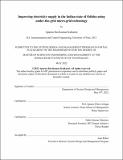| dc.contributor.advisor | Pérez-Arriaga, Ignacio | |
| dc.contributor.advisor | Duenas-Martinez, Pablo | |
| dc.contributor.author | Kulkarni, Aparna Ravikumar | |
| dc.date.accessioned | 2022-08-29T16:20:10Z | |
| dc.date.available | 2022-08-29T16:20:10Z | |
| dc.date.issued | 2022-05 | |
| dc.date.submitted | 2022-06-28T20:27:20.896Z | |
| dc.identifier.uri | https://hdl.handle.net/1721.1/144907 | |
| dc.description.abstract | On 28th April 2018, Narendra Modi the Prime Minister of India announced that every single village of India was electrified. Despite continuous efforts taken by the Indian government through various rural electrification programs, the issue of reliable and affordable electricity persists in the rural areas of India. Besides, the distribution companies (DISCOMs) that provide power supply to the rural areas are in poor financial health due to high operating costs, high AT&C losses, power theft and subsidized consumer tariffs. For the state of Odisha, due to frequent occurrence of cyclones and floods and presence of wildlife activity that make the grid maintenance a complex affair, the DISCOMs incur into exceptionally higher O&M costs. The objective of this thesis is to study some issues that result in systematic economic losses in localized areas for Tata Power Odisha (TPO) who has recently acquired distribution licenses for Odisha and consequently to propose some measures that can mitigate or solve the problem. Multiple hypothetical scenarios were devised considering the potential decisions of TPO and other stakeholders involved in the distribution operation. A techno-economic model was used to simulate these scenarios for a cluster of villages in Odisha looking at the possible outcome for each of them. A reference electrification model was used to obtain the local grid design. Using the best available data to us, the results showed that when performance-based incentives on target reliability are not applied, a local generation operating completely off-grid should be used as an alternative when the annual O&M cost rises above a certain value for the cluster of villages. If incentives are applied, operating the local generation set in a connected microgrid-under-the grid model gives best operating benefits for reliability, performance, and business viability. | |
| dc.publisher | Massachusetts Institute of Technology | |
| dc.rights | In Copyright - Educational Use Permitted | |
| dc.rights | Copyright retained by author(s) | |
| dc.rights.uri | https://rightsstatements.org/page/InC-EDU/1.0/ | |
| dc.title | Improving electricity supply in the Indian state of Odisha using under-the-grid micro-grid technology | |
| dc.type | Thesis | |
| dc.description.degree | S.M. | |
| dc.contributor.department | System Design and Management Program. | |
| mit.thesis.degree | Master | |
| thesis.degree.name | Master of Science in Engineering and Management | |
